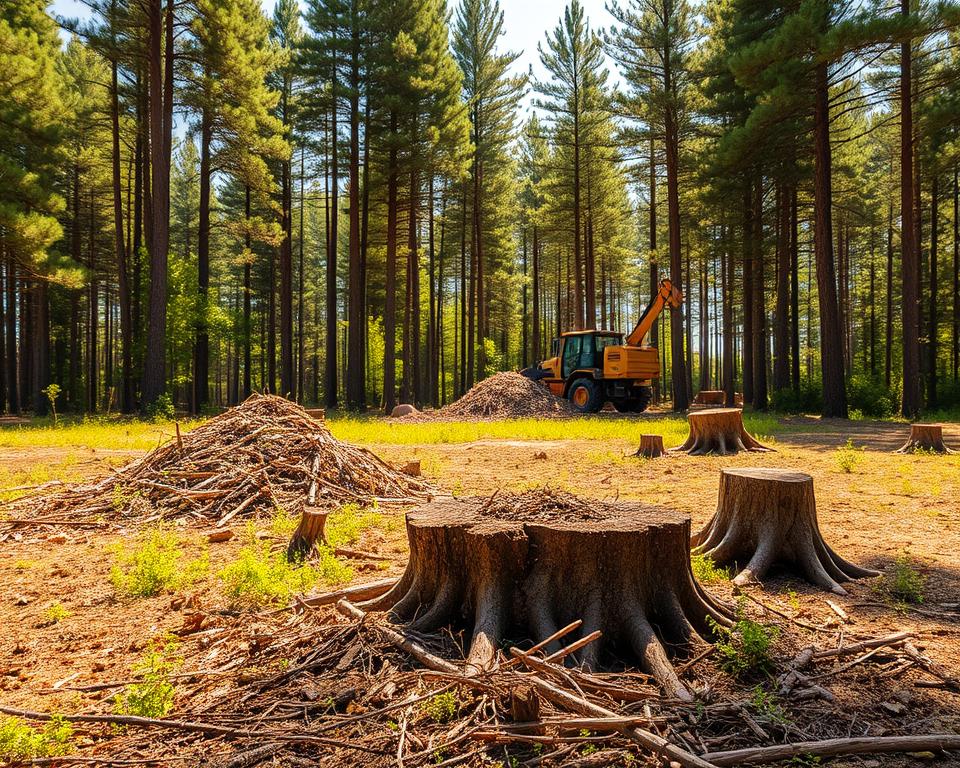Land Clearing Around Water Sources: Prime Methods
Were you aware nearly around seven out of ten of the planet’s fresh water supplies face risks from agricultural drainage and Land Clearing? This eye-opening figure underscores the critical need for responsible land management, essential during water source Land Clearing. Guaranteeing environmental responsibility is vital for maintaining ecosystem equilibrium and protecting aquatic purity and faunal habitats. As communities face growing demands on resources, implementing sustainable land management practices is essential. This approach promotes project success while mitigating soil erosion and minimizing pollution threats in aquatic ecosystems – land clearing.
Core Findings
- Sustainable land management is essential for protecting water quality.
- Implementing best practices can prevent soil erosion and habitat loss.
- Recognizing ecological impacts is vital for responsible Land Clearing.
- Proper planning enhances project success while safeguarding ecosystems.
- Utilizing effective techniques promotes biodiversity in aquatic landscapes.
Comprehending Sustainable Land Clearing’s Importance
Land Clearing involves more than just uprooting vegetation. It has ecological effects of Land Clearing that can harm areas around it, mainly near water. Traditional methods often cause soil erosion, disrupt habitats, and can pollute water. It’s vital to grasp these effects to adopt better land management.
Ecological Effects of Conventional Land Clearing
Standard Land Clearing methods can cause many environmental issues. Loss of vegetation results in soil erosion, soil degradation, and sediment runoff into aquatic systems. These sediments pollute water, affecting aquatic ecosystems. Furthermore, it endangers local fauna and upsets ecological equilibrium.
Sustainable Land Management Options
Adopting sustainable land management practices offers a solution to traditional clearing’s problems. Selective clearing—targeted removal of certain vegetation—maintains ecological equilibrium. Applying erosion control tactics, including cover crops, fortifies soils and maintains water quality. Focusing on native plants supports fauna and enhances ecosystem health.
Essential Best Practices for Land Clearing
Effective Land Clearing begins with thorough comprehension of environmental aspects. It’s vital to assess environmental goals to ensure clearing efforts are effective and sustainable. By setting clear objectives, landowners can make decisions that balance environmental preservation with development needs.

Measuring Environmental Aims
Before starting any clearing project, it’s essential to assess environmental goals. It requires examining the local ecosystem and clearing’s potential impacts on fauna, soils, and water. Identifying personal objectives helps develop strategies that protect local habitats and watersheds.
Selecting the Optimal Time for Clearing
The timing of Land Clearing is key to its success. Clearing during winter or early spring—when soils are frozen—minimizes disturbance and erosion. Understanding avoidance periods results in healthier landscapes and diminished environmental impact.
Evaluating Local Regulations and Permit Requirements
Adhering to local Land Clearing rules is essential for project success. Familiarity with permits sidesteps legal issues and fines. Reviewing local laws, especially near protected zones, prevents environmental mishaps due to unauthorized clearing.
Land Clearing Adjacent to Water Sources: Optimal Techniques
Effective Land Clearing practices around water sources focus on protecting sensitive areas while ensuring ecological balance. A detailed strategy includes locating sensitive zones and using proper erosion control techniques. Such actions are vital to conserving biodiversity and water quality.
Pinpointing Critical Areas for Protection
Prior to Land Clearing, evaluating the terrain for sensitive sites—like wetlands and riparian strips—is crucial. These zones act as natural filters and refuges for multiple species. Proper identification enables land managers to implement safeguards during and post clearing.
Implementing Erosion Control Measures
After identifying critical areas, using erosion control tactics prevents sediment from entering water bodies. Techniques such as silt fencing, natural buffers, and planting cover crops contribute significantly to maintaining water quality. Integrating eco-friendly clearing with erosion management nurtures healthier aquatic environments. This ultimately benefits both the environment and local communities.
Mechanical Versus Manual Clearing Techniques
Choosing between mechanical and manual Land Clearing methods is critical. Each has its own set of advantages and disadvantages, affecting the environment and the clearing process’s efficiency. Understanding these differences helps landowners make informed decisions, aligning with their land management goals.
Pros and Cons of Mechanical Clearing
Mechanical Land Clearing employs heavy machinery to swiftly remove trees, shrubs, and debris. It leads to quicker project completion and less physical labor. However, heavy equipment may disturb soils, cause compaction, and harm ecosystems.
- Pros: Quick removal of extensive regions.
- Lower manual labor expenses.
- Capability to operate on rough landscapes.
- Drawbacks: Greater ecological disturbance.
- Potential for soil erosion.
- Risk of habitat destruction.
Benefits of Manual and Selective Clearing
Manual and targeted clearing emphasize eco-sustainability. Applying specialized labor limits soil disturbance and conserves plants. This approach suits projects where biodiversity and ecosystem health are priorities.
- Advantages: Conservation of indigenous plants.
- Minimized soil disruption and erosion.
- Strengthened habitat protection for fauna.
Methods for Wetland Clearing
Wetland ecosystems are remarkable environments that play a vital role in maintaining ecological balance. They purify water, mitigate flooding, and serve as habitats for diverse life forms. Comprehending wetland function underpins responsible clearing. The aim is to reduce disturbances and protect these crucial aquatic zones.
Grasping Wetland Ecology
Wetlands are defined by distinct water regimes, soils, and plant communities. They serve as transitional zones between terrestrial and aquatic environments, supporting a variety of wildlife. They maintain water quality through filtration systems that eliminate pollutants. Preserving their integrity contributes to overall biodiversity and ecological resilience.
Responsible Wetland Clearing Methods
Careful planning and precise execution underpin responsible wetland clearing. Techniques that promote ecological sustainability can mitigate the negative impacts of Land Clearing. Commonly used strategies include:
- Staging Operations: Conduct clearing in phases to minimize ecological disruption, allowing time for wildlife to adapt.
- Selective Clearing: Remove only specific vegetation types, preserving critical species for habitat stability.
- Regrowth Practices: Introduce practices that encourage natural vegetation regrowth after clearing, maintaining ecosystem functions.
- Establishing Buffer Areas: Establish buffer areas around sensitive wetland sections to protect aquatic habitats from disturbances.
Implementing these techniques confirms that wetland clearing upholds ecosystem services and curbs habitat destruction.
Safeguarding Riparian Reserves in Clearing
Riparian reserves are crucial for healthy water ecosystems. Positioned beside rivers and streams, these zones function as protective buffers. They safeguard water quality and enhance biodiversity. Implementing best practices prevents soil erosion, secures wildlife habitats, and sustains river ecology.
Role of Riparian Buffers in Aquatic Ecosystems
Riparian buffers support aquatic ecosystem health. They filter pollutants, stabilize shorelines, and provide habitats for various species. These buffers act as protective barriers, reducing the impact of human activities on water bodies. Protecting riparian areas enhances water quality, supports fish populations, and strengthens ecosystem resilience.
Best Practices for Maintaining Riparian Zones
Effective riparian reserve maintenance involves these best practices:
- Avoid construction within buffer strips to minimize disturbance.
- Use native vegetation to stabilize banks and prevent erosion.
- Establish a diverse plant community to enhance habitat complexity and support wildlife.
- Manage invasive species to protect native plants and maintain ecosystem stability.
- Regularly assess soil health and water quality to guide management efforts.
Importance of Aquatic Land Clearing Strategies
Clearing strategies near water sources ensure ecological balance and water health. Effective water quality management during clearing reduces pollution risks and promotes sustainability. These approaches mitigate sedimentation and enhance aquatic ecosystem health.
Water Quality and Sediment Management Tactics
Proper water quality control begins with evaluating local water systems. Clearing near waters demands preventing sediments that degrade water quality and aquatic fauna. Strategies include:
- Establishing buffer zones to filter pollutants
- Using sediment traps and barriers to minimize runoff
- Selecting clearing times to coincide with low water levels
These practices shield water quality and sustain ecosystem health. Retained vegetation helps control sediments and cycle nutrients, resulting in healthier water systems.
Promoting Biodiversity in Aquatic Landscapes
Maintaining biodiversity in aquatic landscapes is key for resilient ecosystems. Aquatic land clearing should preserve native species, which are vital for these habitats. Steps to boost biodiversity include:
- Conserving critical habitats during clearing processes
- Implementing phased clearing to allow wildlife adaptation
- Restoring natural vegetation post-clearing to enhance habitat
Embracing these tactics enables managers to nurture biodiversity in water-adjacent areas. These actions yield stronger, more adaptable ecosystems. These efforts safeguard water health and endorse sustainable land-use methods.
Stream Bank and Riverbank Clearing Considerations
Clearing stream banks poses unique challenges, requiring attention to ecological impacts and regulations. The process must honor riverbank requirements to protect water source ecology. Addressing erosion, habitat disruption, and water contamination requires targeted solutions.
Challenges Faced During Stream Bank Clearing
Clearing stream banks encounters multiple obstacles. Erosion is a major concern, causing soil loss and water quality deterioration. Habitat disruption endangers fauna dependent on riparian habitats. Without plants, stormwater runoff surges, depositing sediments in watercourses. These challenges underline the necessity of strategic stream bank management.
Mitigating Erosion and Supporting Healthy Flora
Mitigating erosion is key for stream bank clearing. Introducing native plants stabilizes stream banks. Root systems reduce erosion, promoting a sustainable habitat for local plants and wildlife. Ongoing evaluations during clearing verify method effectiveness, aligning practices with riverbank protection. Robust vegetation aids land management and preserves ecological integrity.
The Final Word
Implementing the best practices for Land Clearing around water sources is essential for maintaining ecosystem health. Stakeholders must focus on sustainable land management. This strategy achieves project aims while safeguarding the environment. Careful planning and execution ensure Land Clearing operations safeguard aquatic ecosystems and preserve biodiversity.
Spotting vulnerable areas and employing erosion measures are crucial steps. Combining mechanical and manual methods supports landowners and contractors in responsible land management. Green practices encourage co-existence of human operations and natural systems. This ensures water sources and adjacent landscapes remain vibrant and resilient.
The commitment to sustainable land management is a collective responsibility. Every action during Land Clearing operations impacts watershed health. By adopting eco-friendly methods, we enable a future where farming and environments thrive together.

